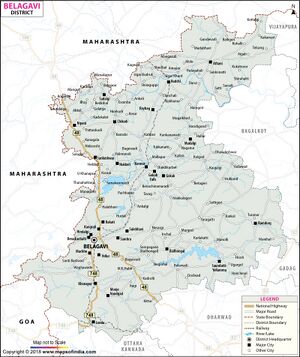Belgaum
| Author:Laxman Burdak, IFS (R) |

Belgaum (बेलगाम) or Belagavi is a city and district in the Indian state of Karnataka located in its northern part along the Western Ghats.
Variants
- Belagavi (official name) [1][2]
- Belagama/Bēḷagāma (बेलगाम) कर्नाटक, (AS, p.643)
- Venugrama (वेणुग्राम) = Belagama बेलगाम, कर्नाटक, (AS, p.643)
- Venupura (वेणुपुर)
- Azamnagar (आजमनगर)
- Belgaon
History
Belgaum was founded in late 12th century AD by the Ratta dynasty, who shifted from nearby Saundatti. A Ratta official called Bichiraja built a Jain temple dedicated to Neminatha in 1204, which came to be called Kamalabasti. Pillars found inside Belgaum fort have Kannada inscriptions in Nagari scripts, one from 1199 by Ratta King Kartaveerya IV. The city original name was Venugrama, a Sanskrit word which means "village of bamboo". Alternatively, it is referred to as Venupura in early Indian texts, which means "city of bamboo".[3]
Belgaum became a part of the Yadava dynasty kingdom (Sevunas) in early 13th century. An inscription from 1261 of King Krishna belonging to the Yadava dynasty attests to this. The region was invaded by Khalji dynasty of Delhi Sultanate in 14th century. Shortly thereafter, the Vijayanagara Empire was founded, and Belgaum came under the rule of Vijayanagara. In 1474, the Bahmani Sultanate conquered Belgaum with an army led by Mahamood Gawan.[4]
The Belgaum fort was strengthened by the Adil Shah dynasty Sultans and they built the Safa Mosque. A Persian inscription states that the mosque was built by Asad Khan, a Bijapur Commander. In 1518, the Bahamani sultanate splintered into five small states and Belgaum became part of the Bijapur Sultanate. The Adilshahis extended their control to the port of Goa, but retreated after the arrival and wars with the Portuguese. In 1686, the Mughal emperor Aurangzeb overthrew the Bijapur sultanate and Belgaum passed nominally to the Mughals, who called it "Azamnagar".[5] However, the Mughal empire control collapsed after the death of Aurangzeb in 1707. The Maratha confederacy took control of the area during the rule of the Peshwas. In 1776, the region was overrun by Hyder Ali and Tipu Sultan after Hyder Ali's coup in the Kingdom of Mysore. The Peshwa regained Belgaum, after Tipu Sultan was defeated by the British forces. In 1818, the British annexed Belgaum and the region in the control of the Peshwa. Kitturu Chennamma (1778–1829) was the queen of the princely state of Kittur in Karnataka and in 1824 she led an unsuccessful armed rebellion against the British in response to the Doctrine of lapse.
Belgaum was chosen as the venue of the 39th session of the Indian National Congress in December 1924 under the presidency of Mahatma Gandhiji. The city served as a major military installation for the British Raj, primarily due to its proximity to Goa, which was then a Portuguese territory. Once the British left India, the Indian government continued and still continues to have armed forces installations in Belgaum. In 1961, the Indian government, under Prime Minister Jawaharlal Nehru, used forces from Belgaum to end Portuguese rule of Goa.
When India became independent in 1947, Belgaum and its district were part of Bombay State. In 1956, the Indian states were reorganised along linguistic lines by the States Reorganisation Act and Belgaum District (except Chandgad Taluk) was transferred to Mysore State, which was renamed Karnataka in 1972.
In 2006, the Government of Karnataka announced that Belgaum would be made the state's second capital, and that the city would be a permanent venue for the annual 15-day session of the state legislature.[6]
बेलगाम
बेलगाम (AS, p.643),कर्नाटक में स्थित है जिसका प्राचीन नाम वेणुग्राम है. [7]
बेलगांव
बेलगांव शहर पश्चिमोत्तर कर्नाटक (भूतपूर्व मैसूर) राज्य, दक्षिण भारत में स्थित है। कहा जाता है कि इस क्षेत्र में पाये जाने वाले बांस पर इसका आरंभिक नाम 'वेणुग्राम' पड़ा था। बेलगांव पश्चिमी घाट में समुद्र तल से 760 मीटर की ऊँचाई पर स्थित है। यह शहर 12वीं शाताब्दी से अस्तित्व में है। बाद में इससे गोवा और पश्चिमी तट पर जाने वाले पठारी मार्गों पर सामरिक नियंत्रण स्थापित कर लिया गया। भारतीय राष्ट्रीय काँग्रेस का 39वाँ अधिवेशन, जो 26-27 दिसम्बर, 1924 ई. को बेलगाँव में ही हुआ था, उसकी अध्यक्षता राष्ट्रपिता महात्मा गाँधी ने की थी। यह शहर कन्नड़, कोंकणी, मराठी और गोवा की संस्कृति का मेल हैं। शाहपुर और माधवपुर बेलगांव के दो उपनगर हैं। [8]
External links
Gallery
-
Belgaum road Map
References
- ↑ "Official Website of Belgaum District". www.belgaum.nic.in.
- ↑ Belgavi, Encyclopædia Britannica
- ↑ Michael W. Meister; Madhusudan A. Dhaky (1996). Encyclopaedia of Indian Temple Architecture. American Institute of Indian Studies. p. 255. ISBN 978-81-86526-00-2.
- ↑ "History of Belgaum". Central Excise Belgaum.
- ↑ "History of Belgaum". Central Excise Belgaum.
- ↑ https://www.outlookindia.com/index/_404
- ↑ Aitihasik Sthanavali by Vijayendra Kumar Mathur, p.643
- ↑ भारतकोश-बेलगांव कर्नाटक


